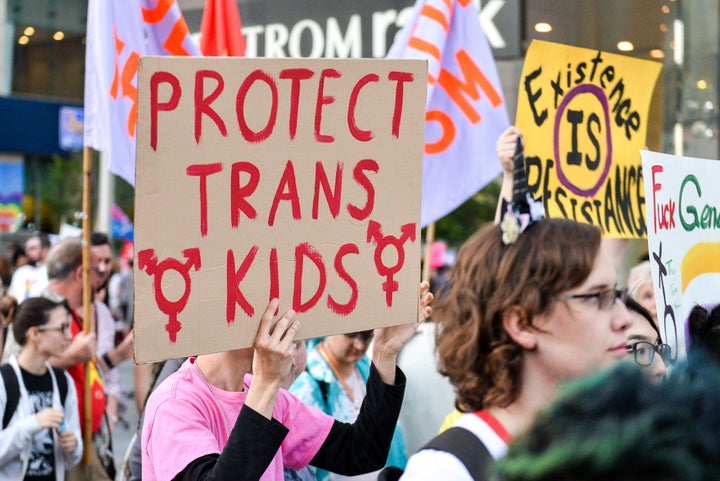Using a transgender or nonbinary kid’s preferred pronouns can quite literally save their life, according to a new survey published Wednesday by The Trevor Project.
The organization, which offers crisis intervention and suicide prevention for LGBTQ youth, found that trans and nonbinary kids attempt suicide at much lower rates when adults use their preferred pronouns and when they’re able to change their gender marker on identification documents.
Even just one accepting adult in an LGBTQ kid’s life can lower their likelihood of attempting suicide by 40%. Trans and nonbinary youth who reported having their pronouns respected by the people they lived with attempted suicide at half the rate of those whose preferred pronouns were not respected, The Trevor Project found.
Unfortunately, more than 60% of transgender youth under the age of 18 said that none of the people they lived with respected their pronouns.
Over 40% of LGBTQ youth seriously considered attempting suicide in the last year. Yet more than half of them said they were unable to get the mental health care they needed.


Nearly 35,000 LGBTQ youth between the ages of 13 and 24 across the U.S. responded to The Trevor Project’s third annual national survey on LGBTQ youth mental health. The survey looks at data including suicide risk factors, mental health care and the effects COVID-19 has had on LGBTQ mental health over the last year.
According to The Trevor Project’s research, 94% of queer youth responded that recent politics had negatively impacted their mental health in the last year. And 75% reported they had experienced discrimination based on their sexual orientation or gender identity at least once in their lifetimes. LGBTQ kids who experienced discrimination in the last year were twice as likely to attempt suicide as those who did not.
This year’s mental health survey has the most diverse pool of respondents since the Trevor Project first began polling LGBTQ youth in 2019. Overall, 45% of respondents were LGBTQ youth of color and 38% were transgender or nonbinary. Half of all LGBTQ kids of color reported experiencing discrimination based on their race or ethnicity in the past year.
The new data comes as dozens of states introduce anti-LGBTQ laws attempting to ban trans kids from school sports and criminalize parents for providing gender-affirming care.
Many of the laws go against recommendations by some of the most respected medical organizations in the country. Dr. Amy Green, vice president of research at The Trevor Project, is worried about how this legislation will directly affect LGBTQ youth but also about the message it sends to queer kids everywhere.
“We’re seeing policies that are working to consistently take away the ability of trans and nonbinary youth to be affirmed in their identity and to live their lives authentically,” Green told HuffPost. “The legal initiatives are of course harmful in what they’ll prohibit, but also they’re harmful in terms of the rhetoric that trans and nonbinary youth are hearing about themselves on a national level in such a consistent way.”
COVID-19 only made tough situations worse for many LGBTQ kids. Only 1 in 3 LGBTQ youth said their home was LGBTQ-affirming, The Trevor Project found, which means that many kids were forced to go back into the closet when they started remote learning due to COVID-19. That number was even higher for trans and nonbinary kids: Sixty percent said the pandemic affected their ability to freely express their gender identity.
“It feels like I lost a part of myself that I had just found,” a gay, gender-fluid college freshman told HuffPost last May during pandemic-related stay-at-home orders. “It’s a lot harder to try to figure out who you are when you really can’t experiment with anything.”
We’re seeing policies that are working to consistently take away the ability of trans and nonbinary youth to be affirmed in their identity and to live their lives authentically.
Dr. Amy Green, vice president of research at The Trevor Project
Some LGBTQ youth, whether in high school or college, are also losing out on integral mental health services that they were able to obtain on campus but no longer have access to at home.
Another college student told HuffPost last May that it felt as though her life was on hold while remote learning because, although her family knew about her sexuality, they refused to acknowledge it. “I think it’s only harder for LGBTQ students because they often have a taste of freedom at college, while it’s the exact opposite at home,” she said.
The good news is that 7 in 10 LGBTQ youth have access to online spaces that affirm their sexual orientation and/or gender identity, according to The Trevor Project’s survey. However, the mental health impacts of social media were a mixed bag: Ninety-six percent of respondents said that social media has a positive impact on their well-being, but 88% also said that it negatively impacts their mental health.
Green said she hopes readers acknowledge the extent of the problem of suicide within the LGBTQ youth community and realize that those risks get even worse for LGBTQ kids of color and trans and nonbinary youth.
“After that, what I want folks to see is that these are not related at all to something that’s inherent about being LGBTQ. These issues are related to the way LGBTQ youth are treated,” she said. “The solution to reducing that risk is to find ways to stop the horrible treatment against LGBTQ youth and to increase support and affirmation.”
If you or someone you know needs help, call 1-800-273-8255 for the National Suicide Prevention Lifeline. You can also text HOME to 741-741 for free, 24-hour support from the Crisis Text Line. Outside of the U.S., please visit the International Association for Suicide Prevention for a database of resources.
Credit: Source link